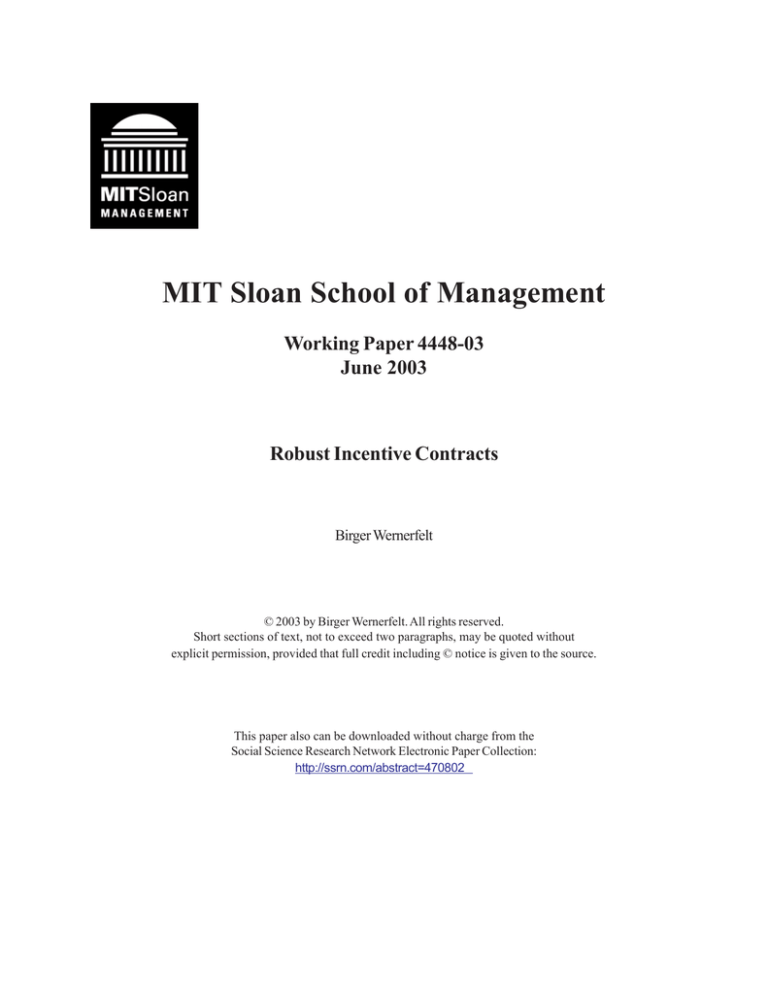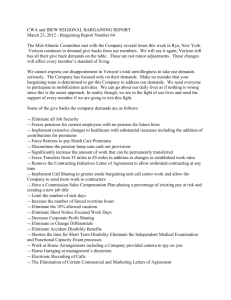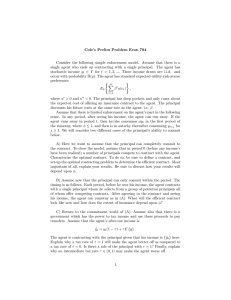
MIT Sloan School of Management
Working Paper 4448-03
June 2003
Robust Incentive Contracts
Birger Wernerfelt
© 2003 by Birger Wernerfelt. All rights reserved.
Short sections of text, not to exceed two paragraphs, may be quoted without
explicit permission, provided that full credit including © notice is given to the source.
This paper also can be downloaded without charge from the
Social Science Research Network Electronic Paper Collection:
http://ssrn.com/abstract=470802
ROBUST INCENTIVE CONTRACTS
Birger Wernerfelt*
June 27, 2003
*J. C. Penney Professor of Management Science, MIT Sloan School of Management,
Cambridge, MA 02142, 617 253 7192, bwerner@mit.edu. The paper has benefited from
comments by seminar participants at the University of California at Berkeley, and in
particular from Steven Tadelis’s very detailed reading of an earlier draft.
JEL Categories: D2, L2
2
ROBUST INCENTIVE CONTRACTS
Abstract
We look at a principal–agent model in which the agent has to perform an action, the
difficulty of which is better known ex interim than ex ante. We compare two contracting
regimes; one with commitment to an ex ante negotiated contract, and one with an ex
interim negotiated contract. The ex ante contract can not be too steep, but attempts to
negotiate a steeper ex interim contract may result in bargaining failure. We find that the
relative efficiency of the two contracting regimes depends on the nature of the differences
between tasks. In a dynamic version of the analysis, we further find that the comparison
depends on the frequency with which new tasks are needed. The argument can be
interpreted as an analysis of the tradeoff between weak incentives in the firm and the
possibility of unsuccessful negotiations in the market.
3
I. INTRODUCTION
The paper compares more or less frequently negotiated incentive contracts in a
dynamic environment. Given a series of tasks of varying difficulty, a long-term contract
will on the average not be second best, but if the players try to negotiate a sequence of
short-term contracts they will occasionally fail to reach agreement. The efficiency and
sustainability of the two contracting regimes is found to depend on how the tasks differ
and how often they change. The comparison can be interpreted as the tradeoff between
weak incentives in the firm and the costs of bargaining in the market.
The first step of the argument is made in the context of a single period principalagent model in which the agent has to perform an ex ante unknown “ideal” task. The
difficulty of the ideal task is ex ante unknown, but as it is identified, both players get
private and public information about its difficulty. We compare the most efficient
contracts from two different regimes: in the “Spot contracting” regime the players try to
negotiate a contract after the ideal task has been identified (ex interim), and in the
“Robust contracting” regime the parties are constrained to an ex ante negotiated contract.
The advantage of Spot contracting is that more information is known at the time of
contracting, such that the incentives can be tailored to the task. The problem is that the
players negotiate the contract under asymmetric information and thus risk suffering
bargaining failures. The pros and cons of Robust contracting are the reverse. Negotiation
takes place ex ante, before any informational asymmetries are realized, but the contract
can not depend on the difficulty of the ideal task. Comparing the two regimes, we
therefore find that incentives are steepest under Spot contracting, while Robust
contracting is more likely to implement the ideal task. In terms of efficiency, the result is,
4
roughly, that Robust contracting is relatively more attractive when the players have more
private and less common information about the difficulty of specific tasks.
Informally taking a further step, we proceed to imbed the model in a dynamic
setting in which the agent has to perform a sequence of different ideal tasks. In this
context, we look at the players’ temptation to renegotiate a Robust contract as well as
conditions under which the prospect of future bargaining will enhance the efficiency of
Spot contracting. Both game forms are found to be asymptotically efficient, but the cost
of contracting suggests that we should be more likely to see Robust contracts when the
ideal tasks change frequently. We go on to suggest that the dynamic version of the model
speaks to the theory of the firm by illuminating the tradeoff between weak incentives in
settings where one player “follows orders” and the costs of bargaining in the market.
Contracts between manufacturers and sales people illustrate the basic tradeoffs in
the model. Over time, the manufacturer will often want to realign sales person territories
and change the set of products sold. If the sales person is an employee, these adjustments
are normally handled without any change in the compensation contract; the sales person
still gets a salary and a percentage of sales as commission. In contrast, if the sales person
is an independent representative, all changes in territory and many changes in products
will trigger renegotiation of the contract. These renegotiations occasionally fail, leading
to dissolution of the relationship and/or expensive legal action (Novick, 1988, Chpts. 11
and 12). On the other hand, independent representatives will normally have steeper
commission rates than employees (Kotler, 2000, p. 498).
5
The paper has some relation to the literature on commitment. In particular
Fudenberg, Holmstrom, and Milgrom (1990) who also compare the performance of a
single long–term agency contract to that of a sequence of short–term contracts. They
show that the former can be better if there is asymmetric information at the time of
recontracting, exactly the case we are looking at. However, the possibility of failed
negotiations does not play a role in their analysis.
The most closely related work is that of Bajari and Tadelis (2001) and Tadelis
(2002), who also show that robust incentives can not be too steep when there is
possibility of bargaining failure. In the former paper, the central endogenous variable is
the probability of renegotiation as determined by the extent to which an incentive
contract is complete. This is then compared to an alternative contract that is completely
flat and therefore can be costlessly renegotiated. Based on these results, Tadelis (2002)
assumes that steeper contracts cause renegotiation costs to go up. In both cases, the idea
is that steepness affects bargaining costs. In the present paper, the causality goes the other
way. Bargaining costs are incurred on a per renegotiation basis, but a more frequently
renegotiated contract can be steeper because more relevant information is known at the
time of writing.
We next derive the central result of the paper in a very simple one-period setting,
while the dynamic extension is discussed in Section III. Sections IV and V contain a
discussion of limitations and an interpretation of the results as speaking to the theory of
the firm.
6
II. STATIC MODEL
A seller may create value for a buyer by exerting effort on one of a large number
of possible tasks. Only the ideal task has value, and the identity of this task is ex ante
unknown. We use the subscript j to indicate a specific task, and introduce ex interim
information in a very simple way by assuming that output is given by
xj = ej + εjs+ εjp+ εjb + εt,
(1)
where ej is effort, εjs, εjp, and εjb are task-specific difficulty parameters, and εt is noise.1
We assume that εjs, εjp, εjb, and εt are independently distributed as N(0,σs2), N(0,σp2),
N(0,σb2), and N(0,σt2), respectively. The seller’s cost of effort is ej2/2, and if he gets
payments w, his utility is –exp[-γ(w- ej2/2)], where γ>0. The buyer is risk-neutral and
each unit of the ideal task is worth 1 to her, while non-ideal units are worth nothing.
In the Robust contracting regime the players negotiate a contract ex ante. Ex
interim, the identity of the ideal task is revealed to both players. Based on this, the seller
can infer εjs, the buyer can infer εjb, and both players can infer εjp. In the Spot contracting
regime the players point negotiate over wj(xj) at this point. Because they have two-sided
asymmetric information, these negotiations may fail (Myerson and Satterthwaite, 1983).
To keep the analysis simple, we make an assumption about the probability of bargaining
failure in the Spot contracting regime:
(A1) The probability of failed bargaining is a constant λ.
1
An alternative, perhaps more appealing formulation is one in which the buyer’s valuation and the seller’s
costs are imperfectly known ex ante. Such a formulation yields similar results.
7
This assumption is very strong since one would expect specific bargaining outcomes to
depend on the realizations of εjs, εjp, and εjb. In particular, since bargaining is more likely
to fail when gains from trade are smaller, (A1) burdens the Spot contracting regime with
“too much” inefficiency. However, the simplification is defensible because the expected
losses from bargaining failure remain positive, while they are zero in the Robust
contracting regime (where the players negotiate under symmetric information).
Still aiming to keep the analysis simple, we furthermore assume that:
(A2) The negotiated Spot contracts are independent of the realizations of εjs and εjb.
Also this assumption is very strong because one would expect the negotiated contracts to
depend on the players’ private information at the time of bargaining. Ex post, this would
reduce the players’ uncertainty and thus the risk-costs associated with Spot contracts. So
(A2) endows the Spot contracting regime with incentives that are “too flat”. However, the
simplification is defensible because we find that even the incentives resulting from (A2)
are steeper than those in the Robust contracting regime.
Given the structure of the model, we can invoke the usual arguments to focus on
linear contracts of the form wj(xj) = αjxj + βj in the Spot contracting regime and w(xj) =
αxj + β in the Robust contracting regime (Holmstrom and Milgrom, 1987). We assume
that the buyer selects αj (α), while the players negotiate over βj (β) to determine the
amount of surplus the seller can expect. After the seller has chosen and expended effort,
the noise is realized and output is measured.
8
In the context of this model, the two contracting regimes can be more specifically
defined and analyzed as follows.
-Spot contracting: At the start of the game, the εjs and εjp associated with the ideal task are
revealed to the seller, while the buyer learns the realizations of εjp and εjb. The players
then proceed to negotiate over wj(xj). Per (A1), these negotiations fail with probability λ.
After agreement on a contract, the seller chooses a level of effort, output is observed, and
payments are made. Neither gets any payoff without a contract.
In this regime, the seller’s certainty equivalent payoff is given by
αj(ej + εjs + εjp) + βj – ej2/2 – γ αj2(σb2+ σt2)/2.
(2)
So he sets ejs=αj, and if bargaining succeeds, the negotiated fixed payment is
βjs = - αj2/2 – αj εjp + γ αj2 (σb2+ σt2)/2+ π,
(3)
where π is the seller’s expected surplus and we rely on (A2). Given this, the buyer’s
expected payoff is
αj + εjp + εjb – αj2/2 –γαj2 (σb2+ σt2)/2- π,
(4)
and she therefore sets
αjs =1/(1+ γ[σb2+ σt2]).
(5)
Because negotiations may fail, no task is implemented with probability λ.
- Robust contracting: Before the ideal task is identified, the players negotiate a contract
w(xj). Because this contract is negotiated before any asymmetric information is revealed,
the negotiation succeeds with probability one. After negotiations, the εjs and εjp associated
9
with the new ideal task are revealed to the seller, while the buyer learns the realizations
of εjp and εjb. At this point the players can neither renegotiate the contract, nor exit the
relationship. Instead, the buyer asks the seller to work on the ideal task, the latter chooses
a level of effort, output is observed, and payments are made.
A Robust contract gives the seller an expected certainty equivalent payoff of
αej + β – ej2/2 – γ α2(σs2+ σp2 + σb2+ σt2)/2.
(6)
So he will set ejr=α, and the negotiated fixed payment is
βr = - α2/2 + γ α2(σs2+ σp2 + σb2+ σt2)/2+ π.
(7)
Given this, the buyer’s expected payoff is
α – α2/2 – γ α2(σs2+ σp2 + σb2+ σt2)/2- π.
(8)
She therefore sets
αr=1/(1+ γ[σs2+ σp2 + σb2+ σt2]),
(9)
and the regime implements the ideal task with probability one.
Comparing the two contracting regimes, we see that the incentives are steepest under
Spot contracting, while Robust contracting implements more of the ideal tasks. To make
statements about the relative efficiency of the two regimes, we first maintain the
(unreasonable) assumption that the probability of bargaining failure (λ) is independent of
the extent of asymmetric information (σs2, σb2). In this case (5) and (9) suggest that Spot
contracting is relatively more efficient when the seller has more important private
information about task-specific difficulty (σs2), when there is more public information
about task-specific difficulty (σp2), and when the buyer has less important private
10
information about task-specific difficulty (σb2). Under the realistic assumption that the
probability of bargaining failure is larger when there is more asymmetric information, the
effect of increases in the seller’s private information (σs2) becomes ambiguous. So we can
conclude that Robust contracting is relatively more efficient when the difficulty of tasks
appear less similar to the buyer, but more similar to the public.
We will now look at a dynamic version of the model to discuss the players’
incentives to break the robust contract as well as the possibility that they treat spot
contract bargaining as a repeated game.
III. DYNAMIC EXTENSION
The static analysis of the Robust contracting regime was based on the assumption
that the players refrain from renegotiating the contract. When Robust contracting is most
efficient in a static setting, this absence of renegotiation can possibly be justified in a
dynamic version by appeal to an implicit contract in the form of a subgame perfect
equilibrium of the repeated game. There is a sea of such equilibria: the players may
employ trigger strategies prescribing permanent reversal to Spot contracting after any
attempt to renegotiate the Robust contract, they may allow each other a limited number of
negotiations per block of periods, or the strategies may be more complicated. In the most
efficient equlibria, a player will elect to renegotiate only when he or she is faced with an
extreme realization of task difficulty in the form of a low εjs+ εjp for the seller or a high
εjp+ εjb for the buyer. As we know from the folk theorem, deviations from the
commitment not to renegotiate become increasingly rare as the inter-period discount rate
decreases.
11
In the context of the model, it does not seem particularly relevant to compare
situations with larger or smaller “per-year” discount factors. It is much more interesting
to contrast situations in which the ideal task changes more or less frequently. To model
this, we hold constant the mean and variance of “yearly” output and look at the effects of
having n>1 periods per year. In this case the inter-period discount factor is the nth root of
the “year-to-year” discount factor and by the usual arguments about the inter-period
discount factor, fewer attempts at renegotiation are sustainable if needs for adjustments
occur more often. In addition, because the variance in individual realizations is smaller,
the slope of the Robust contract is now
αr=1/(1+ γ[σs2+ σp2 + σb2+ σt2]/n).
(10)
Since the limit of this is 1, we conclude that Robust contracting becomes asymptotically
sustainable and first best as the frequency of adjustments grows. So two forces help
enhance the sustainability of Robust contracting as adjustments occur more often: High
inter-adjustment discount factors makes it is easier to uphold an implicit contract not to
renegotiate and the reduced standard deviation of each adjustment allows the use of a
closer-to-first-best contract.
The analysis of repeated Spot contracting is also different because of the possibility
that the bargaining becomes more efficient than was feasible on a static basis. If
bargaining strategies can depend on actions in past bargains, the players could play more
efficient equilibria and enhance the performance of Spot contracting. In particular, it may
be possible to reduce the probability of bargaining failure by playing strategies that allow
the players to pool some of the incentive constraints over several bargaining occasions
12
(Levin, 2003). Again invoking super-game arguments, failures should be less common if
the inter-period discount factor is higher.
Furthermore, there is again a direct effect on incentive-strength mirroring that in
(10), such that with n “yearly” adjustments
αjs =1/(1+ γ[ σb2+ σt2]/n).
(11)
So also for Spot contracting, there are two forces helping to enhance its efficiency as
adjustments occur more often: High inter-adjustment discount factors makes bargaining
more efficient and the reduced standard deviation of each adjustment allows the use of a
closer-to-first-best contract.
Since both regimes asymptotically can implement the first best, the arguments in
the present paper do not help us choose one or the other. However, this does mean that
frequent adjustments render the choice irrelevant. When changes occur with very high
frequency, it may be necessary to worry about the additional communication/ bargaining
activity demanded by Spot contracting. If the players anyway are going to agree on a
contract that differs very little from the most recent one, is it hardly worth spending time
discussing it (Wernerfelt, 1997).
IV. LIMITATIONS
The two game forms compared in the previous sections are obviously not the only
candidates. A particularly interesting alternative is a mechanism in which the seller can
select from an ex ante designed menu of contracts after he has received his private
information. The advantage of such an arrangement is that it allows the players to avoid
negotiating under asymmetric information and thus the risk of bargaining failure.
13
However, because the scheme can not offer the seller less risk that Spot contracting and
the contracts have to differ in terms beyond the intercept, the “truth-telling” constraints
force some distortions on the incentives. So while a menu based game form may be more
efficient in some regions of the parameter space, it does not dominate either of the two
we look at. (It is also interesting that we see so few “real life” examples from this class of
game forms.)
Consistent with the sales force example from the Introduction, the model assumes
the availability of a single scale on which all possibly ideal tasks can be measured. In
many cases this seems like a fair assumption because agents often perform a rather
narrow range of tasks. For example, the tasks could consist of sewing different models of
clothes or washing different windows. On the other hand, there are clearly other
examples, such as secretarial work, in which the natural units of different tasks are very
heterogeneous. In such cases, the only feasible Robust contract is flat. While such
contracts obviously have poor incentive properties, they may still be preferred to Spot
contracts, especially when combined with some subjective measures.
V. INTERPRETATION
If we interpret the Robust contracting game form as an employment relationship, the
paper is part of a literature that highlights a bargaining-cost explanation for the existence
of firms. With this interpretation, the paper contributes to the literature on low-powered
incentives in the firm. It is widely believed that employees face less steep incentives than
independent contractors and the ability to rationalize this is considered an important
property of a theory of the firm. Most arguments offered in the literature are based on the
14
definition that the employee does not own the productive assets. This implies that he can
not successfully bargain for a large share of surplus (Grossman and Hart, 1986), can not
be compensated for hard-to-measure additions to residual claims (Holmstrom and
Milgrom, 1994), and should not be tempted to abuse the assets too much (Williamson,
1985, p.132). The present argument is radically different; it does not depend on assets,
and the distinction between boss and employee is not drawn based on asset ownership.
Consistent with the adjustment–cost theory of the firm (Wernerfelt, 1997; 2002; Simester
and Knez, 2002), we instead define employee–status by an agreement to follow a
sequence of orders without seeking to renegotiate the contract at each turn.
It is also interesting to compare our findings to Simon’s (1951) argument that
employment is more attractive when the variance in the cost of tasks is smaller. He makes
an implicit super-game argument and relies on the possibility that the employee may quit
if faced with a very adverse cost-realization. He does not allow this in the market. We are
looking at the polar opposite case by assuming that the players always honor the robust
(employment) contract, but may fail to reach agreement in the market. If the probability
of failed negotiation depends very steeply on the extent of private information we then
get the opposite result, that the market is more efficient if there is less variance in the
components of difficulty about which the players are privately informed. However, in the
case of public information, our model agrees with Simon since less variance in the
components of difficulty about which both players are informed adds to the relative
efficiency of employment by limiting the associated decay of incentives.
15
REFERENCES
Bajari, Patrick, and Steven Tadelis, “Incentives versus Transaction Costs: A Theory of
Procurement Contracts”, RAND Journal of Economics, 32, no. 3, Autumn, pp. 387-407,
2001.
Fudenberg, Drew, Bengt Holmstrom, and Paul Milgrom, “Short-Term Contracts and
Long-Term Agency Relationships”, Journal of Economic Theory, 51, no. 1, pp. 1-31,
1990.
Grossman, Sanford, and Oliver D. Hart, “The Costs and Benefits of Ownership”, Journal
of Political Economy, 97, no. 4, pp. 691-719, 1986.
Holmstrom, Bengt and Paul Milgrom, “The Firm as an Incentive System”, American
Economic Review, 84, no 4, pp. 972-91, 1994.
Holmstrom, Bengt and Paul Milgrom, “Aggregation and Linearity in the provision of
Intertemporal Incentives”, Econometrica, 55, no. 2, pp. 303-28, 1987.
Kotler, Philip, Marketing Management: Analysis, Planning, Implementation, and Control,
Millennium Edition, Upper Saddle River, New Jersey: Prentice Hall, 2000.
Levin, Jonathan D., “Relational Incentive Contracts”, American Economic Review, 93,
forthcoming, 2003.
Myerson, Roger B., and Mark A. Satterthwaite, “Efficient Mechanisms for Bilateral
Trading”, Journal of Economic Theory, 29, pp. 265-81, 1983.
Novick, Harold J., Selling Through Independent Reps, New York, NY: AMACOM,
1988.
Simester, Duncan I., and Marc Knez, “Direct and Indirect Bargaining Costs and the
Scope of the Firm”, Journal of Business, 75, no. 2, pp. 283-302, 2002.
Simon, Herbert A.,”A Formal Theory of the Employment Relationship”, Econometrica,
19, no.4, pp.293-305, 1951.
Tadelis, Steven, ”Complexity, Flexibility, and the Make-or-Buy Decision”, American
Economic Review, Papers and Proceedings, 92, no. 2, pp. 433-37, 2002.
Williamson, Oliver E., The Economic Institutions of Capitalism, New York, NY: Free
Press, 1985.
16
Wernerfelt, Birger, ”On the Nature and Scope of the Firm: An Adjustment-Cost Theory”,
Journal of Business, 70, no. 4, pp. 489-514, 1997.
Wernerfelt, Birger, ”Why Should the Boss Own the Assets?” Journal of Economics and
Management Strategy, 11, no. 3, pp. 473-85, 2002.








